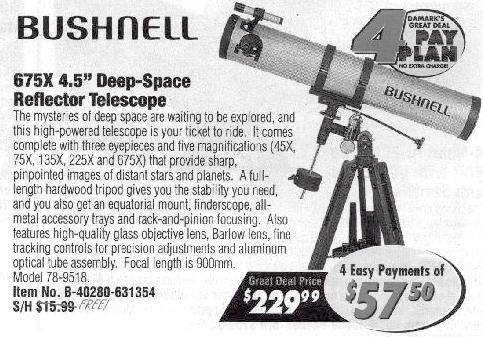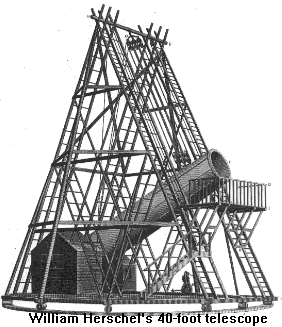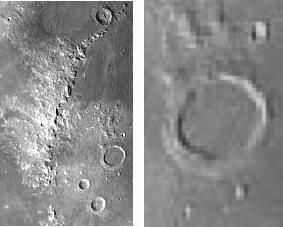The Magnification Game
Jack Kramer
The optics of my 4-inch refractor allow routine use of 150x on some objects. If the seeing conditions are extraordinary, I've bumped it up as high as 270x; however, I can recall using such high magnification on only about a half dozen occasions in the four years or so that I've owned this telescope. Yet how can the 2.4-inch refractors sold in department stores advertise magnifications in excess of 400x...or inexpensive 41/2-inch reflectors give an amazing 675x?
 At public star parties, we're often asked, "How many power is that telescope?" People are usually surprised to hear of the low magnifications we're using. They equate magnification with the ability to see things in the sky, and for the uninitiated, that's what you might expect.
At public star parties, we're often asked, "How many power is that telescope?" People are usually surprised to hear of the low magnifications we're using. They equate magnification with the ability to see things in the sky, and for the uninitiated, that's what you might expect.
Magnification claims by suppliers of department store telescopes are indeed misleading. However, effective use of magnification can work to our advantage. Here are some thoughts on the subject.
There's a long history of identifying a telescope by how much it magnifies. In the 17th and 18th Centuries, it was common to refer to a telescope not by the diameter of its objective, but by its length. Charles Messier used many different telescopes, but in some cases we know only their length, not their diameter. Since focal length determines magnification, the length could be used as a proxy for how much the observers were able to magnify the objects they were observing. (The focal length of the telescope divided by the focal length of the eyepiece equals magnification.) Yet they apparently knew the value of light gathering, as witnessed by their continuing work with ever-larger objective lenses and mirrors.
Even the telescopes used by William Herschel were referred-to in this manner. Many of the objects included in the Astronomical League's Herschel 400 List of deep sky objects were discovered with the "large 20-foot" telescope built by Herschel in 1783. We know it had an 18.7-inch diameter speculum metal mirror, but it was always identified in terms of its length. The same is true of his later "40-foot" telescope.
 Now on to the present day and the issue of high magnification. To help illustrate what happens, let's use the following CCD image of the moon. The picture on the left shows an area of Mare Imbrium with the smooth-floored crater Archimedes at lower right. In the second picture, I homed in on Archimedes and increased the magnification four times. This would be roughly comparable to going from 100x to 400x with a telescope.
Now on to the present day and the issue of high magnification. To help illustrate what happens, let's use the following CCD image of the moon. The picture on the left shows an area of Mare Imbrium with the smooth-floored crater Archimedes at lower right. In the second picture, I homed in on Archimedes and increased the magnification four times. This would be roughly comparable to going from 100x to 400x with a telescope.
 Notice how you really don't see any more detail in the magnified image than in the left image? In fact, the right picture is blurry, and has less contrast. Because the second picture is a greatly magnified CCD image, it's obvious that features are composed of little square pixels. This pixelation, of course, would not be seen in a visual image. However, this illustration does represent how excess magnification becomes self-defeating. Since this was done on a computer, another factor is not taken into account - high magnification accentuates the unsteadiness of the Earth's atmosphere, thus further degrading the image.
Notice how you really don't see any more detail in the magnified image than in the left image? In fact, the right picture is blurry, and has less contrast. Because the second picture is a greatly magnified CCD image, it's obvious that features are composed of little square pixels. This pixelation, of course, would not be seen in a visual image. However, this illustration does represent how excess magnification becomes self-defeating. Since this was done on a computer, another factor is not taken into account - high magnification accentuates the unsteadiness of the Earth's atmosphere, thus further degrading the image.
The size of your objective lens or mirror is an important factor in determining how much magnification you can use. There is a limited amount of light available for a given telescope aperture. We might refer to this as the amount of "information" available in the image presented to the eyepiece. With higher magnification, this light is spread over a wider area, diminishing not only how bright the object appears, but also the sharpness of the image. Specifically, there is a rule in astrophotography that if you double the diameter of the image (i.e.: double the magnification), you are spreading the light over four times the area. With photography, you compensate for this by increasing the speed of the film or the length of exposure. But no such remedy is available for the visual observer. A simple way of looking at what happens when you exceed reasonable limits is that the "information" in the image is spread too thinly.
In fact, some small, faint objects completely disappear under higher magnification. Saturn's moons are a good example. In the 4-inch from my backyard on a night with average seeing, I can usually see the four brightest moons at about 50x, but only two (Titan and Rhea) at 150x. The light from those little pinpoints becomes spread out too much against a light polluted background as magnification is raised.
While high power is useful at times and may actually improve the contrast in an image by darkening the sky background, there is a dividing line between useful and excessive magnification. The rule of thumb is that under perfect skies, the maximum useful magnification is 50x to 60x per inch of telescope aperture. It's sometimes possible to exceed these limits, but not by much. (There's also a minimum effective magnification of 4x per inch, but that's less often an issue.) In addition to atmospheric considerations, the optical design and quality of the telescope also govern the selection of maximum power. For example, on my 10-inch reflector, there's rarely an advantage to using much over 25x per inch. The limit here is imposed primarily by three factors:
- degrading effects of atmospheric instability on larger optics
- less than perfect quality of the mirror
- Newtonian configuration with the central obstruction of the secondary mirror.
On the other hand, I'm able to use more magnification per inch with my refractor because of:
- the smaller size objective that's not so greatly affected by atmospherics
- superior quality optics
- inherently better image quality offered by the unobstructed optical design.
On those very few occasions when I've really pushed the refractor, I still have not exceeded 68x per inch. But a magnification of 675x on a 41/2-inch department store reflector amounts to a whopping (and useless) 150x per inch!
Despite all this, we really can't report Tasco, Bushnell, and Jason to the Better Business Bureau. The claims of excessively high magnification are not false advertising. Department store telescopes do indeed provide 400x or more. The intent is to market them to astronomer wannabes by exploiting their lack of knowledge about magnification. What they get at such high power is a big blur. Then add in the effects of lesser quality optics that don't give a sharp image to begin with, plus shaky mountings that don't permit holding an object steadily in the field of view. You now have a virtually useless telescope.
I always suggest to owners of department store telescopes that they throw away those little 4mm or 6mm peephole eyepieces that supposedly make their scopes so "powerful". Experienced amateur astronomers have an almost missionary zeal to preach the word about using reasonable magnification. It's one of the best ways we can help turn frustrated newcomers into dedicated observers.
Published in the May 2000 issue of the NightTimes




